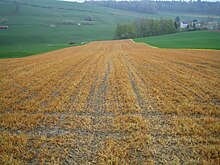

Herbicides (US: /ˈɜːrbɪsaɪdz/, UK: /ˈhɜːr-/), also commonly known as weed killers, are substances used to control undesired plants, also known as weeds.[1] Selective herbicides control specific weed species while leaving the desired crop relatively unharmed, while non-selective herbicides (sometimes called "total weed killers") kill plants indiscriminately.[2] The combined effects of herbicides, nitrogen fertilizer, and improved cultivars has increased yields (per acre) of major crops by three to six times from 1900 to 2000.[3]
In the United States in 2012, about 91% of all herbicide usage, determined by weight applied, was in agriculture.[4]: 12 In 2012, world pesticide expenditures totaled nearly $24.7 billion; herbicides were about 44% of those sales and constituted the biggest portion, followed by insecticides, fungicides, and fumigants.[4]: 5 Herbicide is also used in forestry,[5] where certain formulations have been found to suppress hardwood varieties in favor of conifers after clearcutting,[6] as well as pasture systems.
- ^ EPA. February 2011 Pesticides Industry. Sales and Usage 2006 and 2007: Market Estimates Archived 2015-03-18 at the Wayback Machine. Summary in press release here Main page for EPA reports on pesticide use is here.
- ^ Appleby, Arnold P.; Müller, Franz; Carpy, Serge (2001). "Weed Control". Ullmann's Encyclopedia of Industrial Chemistry. doi:10.1002/14356007.a28_165. ISBN 3-527-30673-0.
- ^ Smil, Vaclav. "Nitrogen Cycle and World Food Production" (PDF).
- ^ a b Atwood, Donald; Paisley-Jones, Claire (2017). "Pesticides Industry Sales and Usage: 2008 – 2012 Market Estimates" (PDF). U.S. Environmental Protection Agency.
- ^ "Governments say glyphosate is safe, but some say 'poison' is being sprayed on northern forests". CBC News. 2 July 2019.
- ^ "GLYPHOSATE AND THE POLITICS OF SAFETY". Halifax Examiner. 7 October 2016.